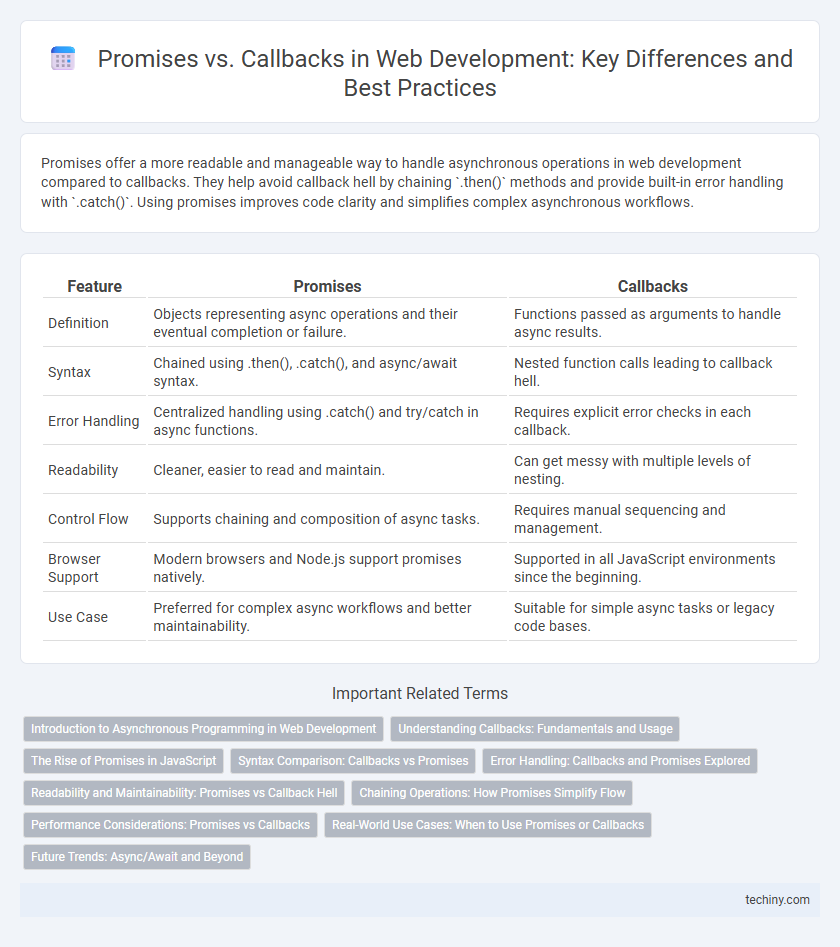Promises offer a more readable and manageable way to handle asynchronous operations in web development compared to callbacks. They help avoid callback hell by chaining `.then()` methods and provide built-in error handling with `.catch()`. Using promises improves code clarity and simplifies complex asynchronous workflows.
Table of Comparison
| Feature | Promises | Callbacks |
|---|---|---|
| Definition | Objects representing async operations and their eventual completion or failure. | Functions passed as arguments to handle async results. |
| Syntax | Chained using .then(), .catch(), and async/await syntax. | Nested function calls leading to callback hell. |
| Error Handling | Centralized handling using .catch() and try/catch in async functions. | Requires explicit error checks in each callback. |
| Readability | Cleaner, easier to read and maintain. | Can get messy with multiple levels of nesting. |
| Control Flow | Supports chaining and composition of async tasks. | Requires manual sequencing and management. |
| Browser Support | Modern browsers and Node.js support promises natively. | Supported in all JavaScript environments since the beginning. |
| Use Case | Preferred for complex async workflows and better maintainability. | Suitable for simple async tasks or legacy code bases. |
Introduction to Asynchronous Programming in Web Development
Asynchronous programming is essential in web development for managing operations like data fetching without blocking the main thread. Callbacks have traditionally handled asynchronous tasks but can lead to complex, hard-to-maintain code known as "callback hell." Promises improve code readability and error handling by representing the eventual completion or failure of asynchronous operations, enabling more efficient management of tasks such as API requests and event handling.
Understanding Callbacks: Fundamentals and Usage
Callbacks in web development are functions passed as arguments to other functions, executed after an asynchronous operation completes. They enable handling tasks like API requests, event listeners, and timer functions effectively by maintaining non-blocking behavior in JavaScript. Proper use of callbacks ensures smoother execution flow but can lead to callback hell, which Promises help to mitigate.
The Rise of Promises in JavaScript
Promises have revolutionized asynchronous programming in JavaScript by providing a more readable and manageable way to handle operations compared to traditional callbacks. Unlike callbacks, promises allow chaining with `.then()` and error handling via `.catch()`, reducing callback hell and improving code maintainability. The widespread adoption of ES6 promises has become a standard approach in modern web development frameworks and libraries, enhancing asynchronous control flow efficiency.
Syntax Comparison: Callbacks vs Promises
Callbacks use nested functions where the callback function is passed as an argument and executed after an asynchronous operation completes, often leading to callback hell with complex nesting. Promises offer a cleaner syntax by returning an object with `.then()` and `.catch()` methods to handle asynchronous results and errors, promoting better readability and chaining. Promises also support async/await syntax, further simplifying asynchronous code compared to traditional callback structures.
Error Handling: Callbacks and Promises Explored
Error handling in callbacks often leads to nested, hard-to-manage code structures commonly referred to as "callback hell," making it difficult to trace and manage errors. Promises provide a more robust and cleaner approach by allowing errors to be caught in a single `.catch()` method, streamlining asynchronous error management. This structured error propagation enhances code readability and maintainability in complex web development scenarios.
Readability and Maintainability: Promises vs Callback Hell
Promises enhance readability and maintainability in web development by providing a clearer, linear structure for handling asynchronous operations, unlike callbacks which often lead to deeply nested code known as callback hell. This nested structure in callbacks complicates debugging and increases the risk of errors, whereas promises enable chaining and better error handling with `.then()` and `.catch()` methods. Modern JavaScript async/await syntax, built on promises, further simplifies asynchronous code, making it more intuitive and easier to maintain.
Chaining Operations: How Promises Simplify Flow
Promises in web development enable chaining operations by returning a new promise from each then() method, allowing sequential execution of asynchronous tasks with cleaner, more readable code. Unlike callbacks that can lead to "callback hell" due to nested functions, promises flatten the flow and simplify error handling through catch() blocks. This chaining mechanism enhances maintainability and clarity in complex asynchronous workflows.
Performance Considerations: Promises vs Callbacks
Promises improve performance in web development by enabling asynchronous code to run more efficiently with better error handling and easier chaining, reducing callback hell and nested functions. Callbacks can lead to increased memory usage and slower execution due to stack buildup and more complex error propagation. Modern JavaScript engines optimize promises to minimize overhead, making them generally faster and more scalable for handling asynchronous operations compared to traditional callbacks.
Real-World Use Cases: When to Use Promises or Callbacks
Promises excel in scenarios involving multiple asynchronous operations that require better error handling and chaining, such as API requests and database queries. Callbacks remain useful for simple event-driven functions or legacy code requiring quick, sequential execution without the overhead of promise constructs. Choosing between promises and callbacks depends on the complexity of the task, readability, and maintainability needs in web development projects.
Future Trends: Async/Await and Beyond
Async/await syntax has revolutionized JavaScript web development by providing a more readable and maintainable way to handle asynchronous operations compared to traditional callbacks and promises. Emerging trends focus on enhancing async/await with features like top-level await, cancellation tokens, and improved error handling to streamline complex workflows. Future advancements aim to integrate declarative concurrency models and observables to optimize performance and scalability in large-scale web applications.
promises vs callbacks Infographic

 techiny.com
techiny.com